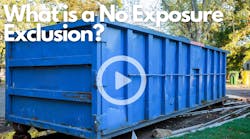Per- and Polyfluoroalkyl substances, otherwise known as PFAS, have become a frequent topic of discussion for water treatment and resource managers. This article examines the often-overlooked role stormwater runoff plays in propagating the PFAS problem.
What are PFAS?
PFAS are a diverse group of synthetic compounds valued for their inherent properties, such as resistance to heat, water and oil. For decades, they have been used to produce hundreds of industrial and consumer products such as carpeting, apparel, upholstery, food packaging, cosmetics, firefighting foams and metal plating.
PFAS are bio-accumulative, meaning they can build up in the bloodstream and tissues of plants, animals and people. Since at least the 1980s, research has found links between PFOS and PFOA (2 common PFAS chemicals) and health problems, such as chronic kidney disease, thyroid issues, certain types of cancers, etc. The U.S. Environmental Protection Agency (EPA) and others are conducting further research to determine the toxicity of other widely used PFAS.
Sources of PFAS in stormwater
PFAS in stormwater can come from a variety of sources. Here are some of the most common.
Industrial runoff – Spills and improper disposal of PFAS at industrial sites can lead to PFAS in stormwater runoff. These sites include manufacturers of PFAS chemicals and industries that use PFAS in their products or production processes. Example industries include textiles, apparel, electronics, metal plating and household goods manufacturers.
Landfills – With so many consumer products containing PFAS, contamination from landfills has become a significant concern. The EPA found elevated levels of PFAS in 95% of the landfills it studied in 2021. As rain, condensation or liquid waste percolates through a landfill, it can leach PFAS from the solid and other liquid waste at the site. Ideally, landfills are equipped with leachate collection systems, but poorly or improperly lined landfills can allow contaminated leachate to migrate into local soils and groundwater. However, as discussed in the next section, even when contaminated leachate is sent to a wastewater treatment facility, the contamination cycle continues.
Construction and demolition sites – Construction materials (wiring, paints, carpeting, weatherproofing, etc.) frequently contain PFAS. When precipitation passes through an on-site (typically unlined) landfill or on-site stockpiles of materials, PFAS concentrations in stormwater may increase.
Airports – PFAS are a traditional component of the aqueous film-forming foam (AFFF) used to fight aviation fires. Although some states now require fluorine-free foams (FFF) to be used for training, none of these formulations has been approved for use in an aviation emergency. Thus, stormwater runoff from airports often contains elevated levels of PFAS.
Other firefighting sites – AFFF is also used to fight chemical fires, so runoff from sites damaged by fire may contain PFAS. Even cleaning equipment used during an emergency or training can lead to an elevated concentration of PFAS in runoff.
Precipitation – Lastly, recent evidence suggests that PFAS can be transported and deposited through natural condensation. A study out of Sweden analyzed wet deposits from various sites around the world for the presence of PFOA, PFOS and a combination of four PFAS (PFOA, PFNA, PFHxS, and PFOS). In both rural and urban areas in the U.S., concentrations were found to exceed the EPA’s health advisory.
No easy answers for managing PFAS in runoff
After washing down the sewer grate, stormwater runoff typically takes one of two paths. In some instances, the Municipal Separate Sewer System (MS4) may route the runoff to a local wastewater facility for treatment. Unfortunately, traditional wastewater treatment does not effectively remove PFAS. In fact, these processes can transform PFAS precursors into terminal PFAS, such as PFOA and PFHxA. These shorter-chain PFAS appear to be more toxic than their longer-chain precursors.
The National Pollutant Discharge Elimination System (NPDES) monitors pollutants discharged into the environment, including from direct sources (untreated stormwater runoff and wastewater discharge) and indirect sources (treated wastewater). While set up by the EPA, this program is largely administered by individual states. The EPA has issued guidance to the states, but there is no universal requirement to include PFAS in NPDES permitting criteria.
Meanwhile, the EPA has allocated funding to help communities address PFAS and other emerging contaminants in wastewater and stormwater infrastructure. However, until a way is found to destroy these “forever chemicals,” there are not any easy answers as to what that infrastructure looks like. For instance, many communities are investing in Granular Activated Carbon (GAC) filtration systems. GAC filters appear to be effective at filtering PFAS out of water, but the contaminated filters still require disposal. Incineration was the preferred method for years, but its efficacy is being questioned following studies that revealed elevated PFAS levels in soil, ash, groundwater and air samples near incineration sites. Landfills are another common option, but as noted above, depositing PFAS in landfills simply cycles PFAS through the water treatment system.
What is in your stormwater?
Even with no easy answers, well-informed decisions usually turn out to be the best decisions. In this case, the decision-making process should start with assessing the concentration of PFAS in your stormwater runoff. EPA drinking water methods 533 and 537.1 are ill-suited for analyzing liquid matrices with suspended solids, so special methods are required.
The EPA is in the process of finalizing Draft Method 1633. This method is already recommended for NPDES permitting, and it may eventually provide an industry-wide standardized testing method for a range of solid and non-potable aqueous matrices.
Draft Method 1621 is suggested by the EPA as a complementary method for NPDES permitting. The EPA Office of Water describes this method as a “Screening Method for the Determination of Adsorbable Organic Fluorine (AOF) in Aqueous Matrices by Combustion Ion Chromatography (CIC).” As drafted, this method can quantify total organic fluorine at the parts-per-billion level in all aqueous matrices.
Environmental labs have also developed lab-specific standard operating procedures based on various quality control protocols, such as the Department of Defense (DOD) Quality System Manual (QSM) Table B-15. For instance, Pace created ASTM D8421/EPA 8327, a test method for solids and non-potable liquids that uses LC/MS/MS (Liquid Chromatography Tandem Mass Spectrometry) and isotope dilution to address some of the challenges with Draft Method 1633.
Finally, TOP Assay is sometimes used to assess Total Oxidizable Precursors (TOP) in a wastewater or stormwater sample. It can be useful for determining the source of elevated levels of total organic fluorine or specific PFAS.
Many variables need to be considered when choosing a test method for wastewater and stormwater analysis. NPDES permitting requirements in your state are at the top of that list. Sample characteristics, such as the percentage of total suspended solids (TSS), can also play a role. Budget and time constraints may as well. A qualified lab should be able to help you choose the right method for your project requirements.






